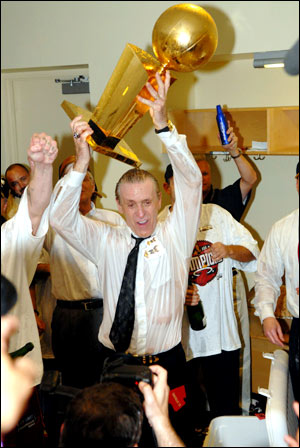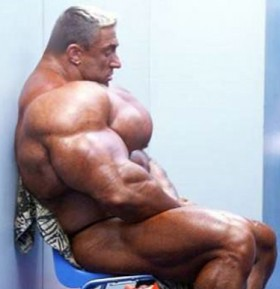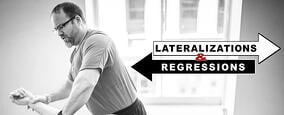How do you avoid complacency in a team setting?

RILEY: First of all, you have to realize that complacency is a way of life. You don’t ever avoid it. You have to alert your players to the fact that there are so many things that can get between them and what you are trying to teach them.
You can’t become distracted and let all of these things get into the way and take your mind off of the prize. It’s a deadly disease because it simply gets in the way of your energy and your effort. And when your energy and your effort are down, your efficiency is going to be down.
(Interview questions and answers taken directly from the February 2007 edition of Scholastic Coach & Athletic Director)
Topics:
basketball performance,
basketball resources,
basketball training programs,
athletic training,
Ownership,
Pat Riley,
discipline,
customer service,
development,
Leadership

In a recent post by Seth Godin he challenges one’s normal approach to problem solving which is usually the “wait to be inspired then act” method and asks us to instead actively seek out inspiration.
Seth states, “Simple example: start a blog and post once a day on how your favorite company can improve its products or its service. Do it every day for a month, one new, actionable idea each and every day. Within a few weeks, you'll notice the change in the way you find, process and ship.”
My challenge to you is to take Seth’s example of blogging, but instead of blogging about your favorite company, write down one new actionable idea each and every day this coming month that will improve your department’s service to your student-athletes. It may be as simple as greeting each athlete or patient with a high five as they enter your office or as complex as a new pre-participation exam that actually screens them for risk factors that matter. Or how about an idea that will provide your staff with more opportunities to ship?
Once you’ve committed to writing down these ideas you’ll not only discover there are a number of easy ways to improve your services, but you’ll actually find yourself leading others to the trough of change.
Warning: you can lead a co-worker to water, but you can’t make them drink. But gosh darn it, seeing you drink first makes it a whole lot easier for others to drink the cool-aid.
Art Horne is the Coordinator of Care and Strength & Conditioning Coach for the Men’s Basketball Team at Northeastern University, Boston MA. He can be reached at a.horne@neu.edu.
Topics:
athletic training,
Strength & Conditioning,
motivation,
Ownership,
Good to Great,
discipline,
customer service,
evidence based medicine,
development,
Leadership,
managing

A good friend from Australia sent me this clip about workplace motivation. Besides the awesome animation, it’s just under 11 minutes and worth every second of it.
It may surprise you that monetary incentives are not the lead motivator in the workplace, but instead the three factors that lead to better performance and personal satisfaction are:
Autonomy: desire to be self directed.
Mastery: our urge to become better.
Purpose: When profit motive becomes unmoored from purpose motive bad things happen (bad customer service, crappy products, etc).
How does this change your management strategy this week?
Art Horne is the Coordinator of Care and Strength & Conditioning Coach for the Men’s Basketball Team at Northeastern University, Boston MA. He can be reached at a.horne@neu.edu.
Topics:
basketball conference,
athletic training conference,
athletic training,
Strength & Conditioning,
motivation,
autonomy,
purpose,
mastery,
Good to Great,
discipline,
customer service,
development
Just in case you missed it, earlier this week 19 Oregon Football Players were hit with a “very weird” illness after a workout session. One doctor called it a compartment syndrome, I’m guessing this one smells a bit more like Exertional Rhabdomyolysis (RAB-DOE-MY-O-LIE-SIS) or Rhabdo.
What is this strange animal you may ask? Simply stated, Rhabdo is a rapid breakdown and destruction of skeletal muscle resulting in the release of muscle fiber contents or myoglobin into the bloodstream. Symptoms include:muscle pain, weakness and swelling along with cola colored urine.
No problem right? That’s how you build big muscles, you tear um down first to then build them bigger and better! What doesn’t kill you makes you stronger!

Well, not exactly. You see, Rhabdo can ultimately lead to death via kidney failure.
So what causes Rhabdo?
The list includes but not limited to:
• muscle trauma or crush injury
• severe burns,
• physical torture or child abuse
• prolonged lying down on the ground (people who fall or are unconscious and are unable to get up for several hours)
• prolonged coma,
• severe muscle contractions from prolonged seizures
• cocaine use with related hyperthermia (increased body temperature),
• extreme physical activity (running a marathon),
• low circulating phosphate, potassium, or magnesium levels in the blood (electrolytes)
• prolonged drowning or hypothermia (low core body temperature)
• lack of blood perfusion to a limb
Pretty extreme stuff isn’t it? Here is some more info: http://www.bsmpg.com/exertional-rhabdomyolysis
Other contributing factors include: initial fitness level at the beginning of a training program, extreme heat and levels of dehydration.
Now I wasn’t in Oregon this week, nor do I have any additional information regarding the type of training these young men were doing and for the purpose of this rant it doesn’t matter. My only goal is to provide a basis for conversation between your Sports Medicine and Performance Departments on how to recognize the onset of Rhabdo, and better yet avoid it all together. And although there’s plenty of football and hockey dads out there that pay good money to coaches around the country to make their kids puke during workouts, I hope that a culture of “superdiscipline” and common sense instead becomes the standard conditioning test this fall.
Now drop and give me 500!
Art Horne is the Coordinator of Care and Strength & Conditioning Coach for the Men’s Basketball Team at Northeastern University, Boston MA. He can be reached at a.horne@neu.edu.
Topics:
athletic training,
Strength & Conditioning,
Health,
mental training,
rhabdomyolysis,
discipline,
evidence based medicine,
mental toughness

On line resources define Evidence Based Medicine as the following:
ev•i•dence-based med•i•cine
noun
Definition:
treatment based on reliable evidence: the use of clinical methods and decision-making that have been thoroughly tested by properly controlled, peer-reviewed medical research.
Now that we got that out of the way we can move forward with your definition?
The same?
You sure?
No other phrase has infiltrated both sports medicine and strength and conditioning more in the past decade, and for good reason. It guides clinical practice and allows us to allocate resources, time, and personnel towards obtaining best practice. The problem is not with evidence based medicine but with individuals providing “their own definition” in defense of the work they are conducting.
So the next time your co-worker starts ultra-sounding an entire thigh simply ask them what their definition of evidence based medicine is. Hint: we are not allowed to each have our own definition.
Art Horne is the Coordinator of Care and Strength & Conditioning Coach for the Men’s Basketball Team at Northeastern University, Boston MA. He can be reached at a.horne@neu.edu.
Topics:
basketball conference,
basketball training programs,
athletic training conference,
athletic training,
Strength & Conditioning,
Health,
Good to Great,
discipline,
evidence based medicine,
development,
Leadership,
managing

A business friend of mine is always talking about gaps in the market and turning a profit. Always looking to fill only those gaps that have a market and thus place only resources where they are best utilized. In discussing our department and without knowing anything about Sports Performance, the first question he asked me was this,
“Is there a gap in the market? And is there a market in the gap?”
A classic example of a gap in the market was the introduction of the Segway. At the time, and still to this day, there was no machine that enabled a person to stand upright and zip around at a running speed with little or no effort. A clear example of a gap in the market.
The problem that the makers of the Segway ran into was that they never followed up the first question with the second and asked themselves, “Is there a market in the gap?”
Besides a few mall rent-a-cops, the Segway basically was a flop – no market in the gap despite the massive gap in the market.
If you follow the NBA, you’ve no doubt heard the story of Kevin Durant’s failed bench press attempt at the NBA combine his rookie year. Kevin Durant can’t bench 185 lbs; some would say a clear a gap in his physique (market). What many failed to see though, was that there was absolutely no need to fill this gap in Kevin’s physique. Developing Kevin’s physique so that he could bench press 225 lbs, although fulfilling your ego, will not make him play any better… and hence no market in that gap. When examining your athletes both in rehab and performance the question we need to ask when addressing these programs is simple.
Is there a market in their gap? And if not, we need to start putting our resources into gaps that are marketable.
Art Horne is the Coordinator of Care and Strength & Conditioning Coach for the Men’s Basketball Team at Northeastern University, Boston MA. He can be reached at a.horne@neu.edu.
Topics:
basketball resources,
athletic training,
Strength & Conditioning,
Ownership,
Kevin Durant,
discipline,
development,
Leadership,
managing

There's an employee outside of my department that I've known for some years. For pretty much the entire time I have known them they have been telling people they were planning on leaving for greener pastures soon enough. This has been going on for about five years now, but for some reason they have been unable to find a situation that better suits their needs. In the interim, let's just say that they have not been the model of ownership. Sure, they do their job, but along the way they also complain about their responsibilities, their poor compensation, and the state of their department in general to anyone willing to listen. They also fail to understand why it is that they are still stuck in a less than ideal circumstance and are unable to find another job. Hmmm, baffling.
You may recognize it, but the title of this post is taken from a quote by entrepreneur Shawn Carter who you may know better as Jay-Z. Over the years Carter has continually reinvented himself and excelled in every avenue that he's explored. He has gone from being a successful artist to owning a record label, his own major clothing line, a chain of upscale sports bars, and an ever increasing number of other ventures. Carter continually excels because he has the drive to succeed, but also because he understands that his name is a brand. In today's age many artists, athletes and other celebrities continually make poor decisions that ultimately paint their names in a negative light and simultaneously limit their future potential. While many of these people do not fully understand that their name is their brand, Carter grasps the notion that while he is marketing all of his businesses, more importantly he is marketing himself.
What does this have to do with you? Let's forget about the effect your actions have on your workplace for a minute and focus on the effect they have on you. Every decision you make, every meeting you attend, and every conversation you have impacts the way that supervisors, employees, and co-workers perceive you. When you complain about your surroundings, belittle your fellow employees or put forth a mediocre effort you are definitely influencing your image, but is that really the image you want to put forth? Your brand is what ultimately makes the difference between advancing in your profession and continuing to work in a position that is less than your ideal circumstance. You are your own business and you should be marketing yourself accordingly. Shawn Carter knows it. Why don't you?
Shaun Bossio is the Assistant Business Manager and ProShop Manager at Boston University FitRec.
He can be reached at sbossio@bu.edu
Topics:
basketball performance,
athletic training conference,
athletic training,
Strength & Conditioning,
Ownership,
shawn carter,
jay-z,
Good to Great,
discipline,
development,
Leadership
Everyone’s entitled to their own opinion but not their own facts.
When meetings boil down to people’s opinions, I usually have to leave. I know that we are each entitled to our own opinion. I get that.
But don’t confuse your opinion with facts.
“Well, I feel this would be the best solution…”
Did you look at the distributor? Is there a cheaper way to get the same product? What about the warranty? How does it fit into our business model or fit our core principles? Is there evidence based literature that supports its use and price tag? Will it serve a large group or can it only be used by one individual at a time?
Facts take time to investigate. They take energy and a “superdisciplined” approach. Opinions are like talk at the barbershop.
I’ll take an order of more facts please.
Art Horne is the Coordinator of Care and Strength & Conditioning Coach for the Men’s Basketball Team at Northeastern University, Boston MA. He can be reached at a.horne@neu.edu.
Topics:
basketball resources,
athletic training conference,
athletic training,
Strength & Conditioning,
Ownership,
Good to Great,
discipline,
customer service,
development,
Leadership,
managing
I had a manager from another company give me a call recently for a reference on a employee that worked for me several years ago. He explained a little about the position and then I in turn told him a little about the employee's responsibilities here and how this particular person fit in with the group. When I was done, he asked me how this employee stood out from the rest. Great question. My answer was immediate and without hesitation; they were one of my top students because they took ownership of their position.
What is ownership exactly? It's the difference between someone who does the minimum of what is expected of them and someone that takes a legitimate interest in improving their workplace. Let's take the Ownership Quiz . . .
* During staff meetings, are you the person who volunteers for new tasks/projects or are you the person who lowers their eyes hoping someone else raises their hand?
* Do you take pride in the work you do on a day to day basis or do you simply do what is asked of you and be glad it's done?
* Do you take the initiative, bringing ideas for positive change to your office or are you the person that simply complains about how things could be better?
* If there is an issue outside of business hours, do your coworkers know it's alright to contact you or are they under the impression that would be a cardinal sin?
* Do you subscribe more to the idea of getting your job done rather than the phrase "business hours" or are you punching a clock at 9a and 5p every single day?
What if your well-being was tied directly into the performance of your whole office? Well, I've got news for you. It is. Ownership is about treating your position as if you owned your own business. It is about being a catalyst for positive growth in your environment regardless of whether you are the VP or an entry-level employee. When you own your position, you are telling your supervisors, your co-workers, and the employees under you that you care. You are providing a positive example for all and working towards bettering your environment regardless of the situation. The highest compliment that I can give to any of my employees is that they took ownership of their position. These are the ones that stood and continue to stand out from the crowd, even years later.
Are you taking ownership of your workplace or just getting in the way of those that do?
Shaun Bossio is the Assistant Business Manager and ProShop Manager at Boston University FitRec.
He can be reached at sbossio@bu.edu
Topics:
basketball resources,
basketball training programs,
athletic training conference,
boston hockey summit,
athletic training,
Ownership,
Good to Great,
discipline,
athletic trainer,
customer service,
everything basketball,
development,
managing,
Announcements
The initial part of investing is tough.
Whether its withdrawing a thousand dollars from your checking account to be placed in a high interest bond you can’t touch for 4 years, or the time you spend filling out your salary withholdings for your 401K retirement plan. Putting “money in the bank” is tough.
It’s a whole lot easier to buy that extra pair of shoes you don’t need, or dine out at the restaurant down the street (again) instead of making dinner at home.
The same can be said at work.
Whether it’s investing time in a project to unify the language and exercise descriptions between the sports med and the strength staff, working with student-athlete welfare to design, manage and implement a comprehensive sports nutrition strategy or designing and tracking an injury assessment and prevention protocol for all athletes. Putting “money in the bank” is tough.
It’s a whole lot easier to just let the weight room do their thing then complain about it , tell your athletes not to eat fast food (then sneak a McDeal Meal to your desk without them seeing), and just take vitals as your normal incoming screening process (I mean, that’s all the NCAA asks you to do)
What makes investing so difficult is that the investor, rarely ever sees a tangible return on investment within any “reasonable” amount of time. That’s what makes investing in mutual funds so successful though. If you invest in them, they almost always pay off long term. The same can be said for your investments at work; your return on investment is rarely within site, even though you know it will pay off eventually.
Will you ever see the lack of arteriosclerosis that your nutrition plan and cooking classes had on your athletes? What about the injury you may or may not have prevented from your screening and intervention strategies?
The answer is you probably won’t. Your athletes and patients are only yours for four years. And like any good mutual fund, these investments take time to mature. But just because you can't see the end result next week doesn't mean you stop investing.
The only return you’ll see now is a smile and a thank you. But just like mutual funds, the investments you make at work today will always pay off in the future just as long as you keep putting money in the bank.
Art Horne is the Coordinator of Care and Strength & Conditioning Coach for the Men’s Basketball Team at Northeastern University, Boston MA. He can be reached at a.horne@neu.edu.
Topics:
basketball conference,
basketball training programs,
athletic training conference,
athletic training,
Good to Great,
female strength training,
Leadership,
managing









